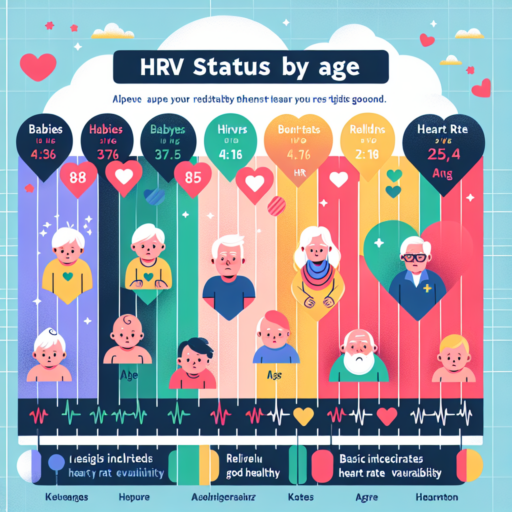Understanding HRV: What Is Heart Rate Variability?
Heart Rate Variability (HRV) is a measure of the variation in time between each heartbeat. Contrary to popular belief, a healthy heart does not tick away with the precision of a metronome; instead, it slightly varies its rhythm with each beat. This variability in heartbeat is a critical indicator of our physical and mental well-being, signifying the balance and adaptability of our autonomic nervous system.
HRV is calculated by analyzing the time interval between heartbeats, measured in milliseconds, and is recognized as a vital biomarker for stress, fitness, and overall health. A higher HRV means that your body is well-equipped to adapt to stress and recover from exercises, whereas a lower HRV suggests a need for rest and recuperation.
Understanding HRV is essential for anyone looking to optimize their health, performance, and recovery. By monitoring HRV, individuals can make informed decisions about adjusting their training intensity, managing stress, and improving sleep quality. Moreover, with the advent of wearable technology, tracking your HRV has become more accessible than ever, providing valuable insights into your body’s readiness and resilience.
Why Monitoring Your HRV in Your 30s Is Important
Monitoring your Heart Rate Variability (HRV) is a crucial aspect of understanding your overall wellness, especially in your 30s. HRV measures the variation in time between each heartbeat, which is directly linked to your autonomic nervous system. It serves as a critical biomarker, giving insight into your body’s stress levels, recovery status, and overall heart health.
The Importance of HRV in Your 30s
During your 30s, life’s responsibilities might peak, bringing on increased levels of stress. This can have a significant impact on your cardiovascular system. Monitoring your HRV can help you understand how your lifestyle is affecting your health. By tracking changes in your HRV, you can make informed decisions about stress management, exercise, and rest, ensuring you maintain a balance that fosters good health.
Moreover, as you age, your risk of developing various cardiovascular diseases begins to increase. Regular HRV monitoring can serve as an early warning system, indicating potential health issues before they become severe. By paying attention to your HRV, you can take proactive steps towards maintaining heart health, such as adjusting your diet, incorporating regular physical activity, and managing stress effectively.
Lastly, HRV is a valuable tool in optimizing your fitness routine. In your 30s, you might notice changes in how your body responds to exercise. An HRV monitoring can highlight when your body is in a prime state to tackle high-intensity workouts or when it needs more time for recovery. This insight allows you to customize your fitness regime to match your body’s needs, maximizing benefits while minimizing the risk of injury or burnout.
In sum, HRV monitoring in your 30s is an essential practice for maintaining and improving your health, fitness, and overall quality of life. It empowers you with data to make lifestyle choices that can enhance your wellbeing for years to come.
How HRV Changes As You Age: What Happens in Your 30s?
Understanding how Heart Rate Variability (HRV) shifts with age, particularly in your 30s, is crucial in gauging overall wellness and cardiovascular health. As individuals transition from their 20s into their 30s, distinct changes in HRV patterns can be observed. This period often signifies a transformation in both lifestyle and physiological functions, where the implications of HRV modifications become more pronounced.
In your 30s, the body undergoes various physical adjustments, leading to a gradual decrease in HRV. This shift is indicative of age-related autonomic nervous system changes. The autonomic nervous system, responsible for regulating involuntary body functions, including heart rate, begins to lose some of its efficiency. As a result, the heart’s ability to swiftly alter its beating pattern in response to stress, physical demands, or relaxation phases diminishes. Such a decline in HRV is a marker of reduced cardiovascular fitness and agility, spotlighting the importance of monitoring HRV as one progresses through the decades.
Moreover, lifestyle factors in your 30s, such as increased stress levels, busier schedules, and possibly lesser focus on physical activity, with an inclination towards sedentary behavior, further influence HRV. These lifestyle changes correlate with a lessened ability of the heart to adapt and respond to varied stimuli, emphasizing the significance of maintaining a healthy lifestyle to support optimal HRV levels. Research suggests that engagement in regular physical activity and stress management practices can help mitigate the natural decline in HRV associated with aging.
No se han encontrado productos.
Top Ways to Improve Your HRV for a Healthier Life in Your 30s
Improving your Heart Rate Variability (HRV) is crucial for maintaining good health, especially in your 30s when stress levels can be particularly high. An optimal HRV indicates a balanced autonomic nervous system and is associated with better cardiovascular fitness, stress resilience, and overall health. Here are some effective strategies to boost your HRV and enhance your well-being.
Regular Physical Activity
Incorporating regular physical activity into your routine is one of the most effective ways to improve your HRV. Whether it’s brisk walking, jogging, swimming, or cycling, engaging in moderate to vigorous exercise for at least 150 minutes per week can significantly enhance your cardiovascular system’s efficiency, thereby boosting your HRV. The key is consistency and enjoying the activities you choose, so they become a sustainable part of your lifestyle.
Mind-Body Practices
Mind-body practices like yoga, meditation, and tai chi are not only excellent for reducing stress but also particularly beneficial for improving HRV. These practices promote relaxation, which in turn helps in balancing the sympathetic (fight or flight) and parasympathetic (rest and digest) nervous systems. Engaging in mind-body exercises for a few minutes daily can lead to noticeable improvements in HRV over time.
Optimizing sleep quality is another cornerstone of improving HRV. Ensuring that you get a consistent 7 to 9 hours of quality sleep nightly can have a profound impact on your heart rate variability. During sleep, your body undergoes essential recovery and regulatory processes that are critical for maintaining heart health and a balanced nervous system. Avoiding screens before bedtime, keeping a regular sleep schedule, and creating a restful sleep environment can significantly enhance sleep quality and, by extension, HRV.
The Connection Between HRV and Stress Management in Your 30s
Understanding the relationship between Heart Rate Variability (HRV) and stress management becomes increasingly crucial as you navigate through your 30s. This decade of life often brings about unique stressors, such as career advancement, family responsibilities, and the onset of health concerns. HRV, a marker of autonomic nervous system functioning, plays a key role in how effectively individuals can cope with stress during this pivotal period.
HRV is indicative of your body’s resilience to stress. A higher HRV reflects a stronger ability to switch between fight-or-flight and rest-and-digest states, allowing for better stress management. In our 30s, leveraging HRV can guide us to adopt healthier lifestyle choices, from improved sleep habits to mindfulness practices, all of which profoundly impact our stress resilience.
Adopting techniques to improve HRV can serve as a cornerstone for stress management strategies. Simple interventions, such as controlled breathing exercises, regular physical activity, and engaging in relaxation practices like yoga or meditation, can enhance HRV. Such practices not only fortify our stress response mechanisms but also improve overall well-being and quality of life during the often turbulent third decade.
Using HRV Data to Enhance Your Fitness Routine in Your 30s
Entering your 30s brings about a shift in how your body responds to exercise and stress. This is where Heart Rate Variability (HRV) data comes into play, offering a nuanced window into your overall well-being and fitness. HRV, the variation in time between each heartbeat, is a critical biomarker for assessing recovery status and adjusting your fitness regimen for optimized performance.
Utilizing HRV data can significantly enhance your fitness routine by providing insights into when to push harder and when to prioritize recovery. For those in their 30s, balancing work, life, and exercise can be challenging. Incorporating HRV data helps create a tailored fitness plan that aligns with your body’s readiness, enhancing both efficiency and effectiveness. It’s not just about working harder but working smarter, allowing for precise adjustments in exercise intensity and volume based on your body’s signals.
To begin with, monitoring your HRV can guide you in identifying patterns and recognizing when your body is under stress or when it’s optimal to undertake high-intensity workouts. Adapting your workout intensity based on HRV readings can lead to improved fitness levels, better recovery, and reduced risk of overtraining or injury. Furthermore, this personalized approach fosters a healthier relationship with fitness, making it a sustainable part of your lifestyle through your 30s and beyond.
Nutrition and HRV: What Foods Boost Heart Rate Variability in Your 30s?
Understanding the impact of nutrition on heart rate variability (HRV) is crucial, especially as you navigate through your 30s—a time when lifestyle choices begin to have a more pronounced effect on health. HRV is a measure of the variation in time between each heartbeat, and a higher HRV has been linked to better cardiovascular health, stress management, and overall longevity. But, what specific foods can help boost HRV? Let’s dive into the heart of the matter.
Omega-3 Rich Foods: Omega-3 fatty acids are fundamental in enhancing HRV. Foods like salmon, mackerel, and chia seeds not only support heart health but also improve HRV by reducing inflammation and improving autonomic heart control. Incorporating a serving of omega-3 rich foods into your daily diet could be a potent step toward bolstering your heart’s resilience.
Antioxidant-rich Fruits and Vegetables: Antioxidants play a pivotal role in neutralizing free radicals that can lead to oxidative stress—a condition that adversely affects HRV. By consuming a diet high in antioxidant-rich fruits and vegetables, such as berries, kale, and bell peppers, you provide your body with the tools it needs to fight oxidative stress and enhance HRV. These foods not only protect the heart but also support overall health and vitality.
Magnesium-rich Foods: Magnesium is a crucial mineral that greatly influences heart health and HRV. It helps in regulating heartbeat, reducing blood pressure, and controlling stress levels. Foods high in magnesium, like spinach, almonds, and avocados, can therefore be incredibly beneficial for improving HRV. Incorporating these nutrient-rich foods into your meals can help ensure your heart beats not just strongly, but also with harmonious variability.
Technological Advancements: The Best HRV Monitors for People in Their 30s
In the dynamic realm of health and fitness technology, Heart Rate Variability (HRV) monitors have emerged as a cutting-edge tool for those seeking to optimize their wellness routines. Specifically, for individuals in their 30s, selecting the right HRV monitor can be a game-changer in managing stress, improving cardiovascular health, and enhancing overall well-being. This age group often juggles numerous responsibilities, making stress management and fitness monitoring more crucial than ever. Thankfully, technological advancements have led to the development of HRV monitors that are both highly accurate and user-friendly.
Among these innovations, several HRV monitors stand out for their precision, ease of use, and comprehensive data analysis. First, wearables that integrate HRV tracking with daily activity and sleep patterns offer a holistic view of one’s health, directly from the wrist. These devices are designed with the busy lifestyle of the 30-something in mind, providing insights that can help tailor fitness and recovery plans to one’s unique physiological markers. Furthermore, advancements in sensor technology mean that today’s HRV monitors are not just accurate but also extraordinarily comfortable for continuous wear.
Additionally, smartphone apps that work in tandem with these wearables have become an indispensable tool for real-time health monitoring. Enhanced with artificial intelligence, these apps can interpret HRV data and provide personalized recommendations, empowering users to make informed decisions about their lifestyle choices. Whether it’s adjusting workout intensity, improving sleep hygiene, or managing stress, these applications offer practical guidance based on concrete data.
HRV Success Stories: How People in Their 30s Improved Their Heart Health
Exploring the landscape of heart health, especially in the crucial decade of one’s 30s, has brought forward some remarkable HRV (Heart Rate Variability) success stories. These accounts not only pave the way for a deeper understanding of cardiovascular wellness but also serve as beacons of inspiration for individuals aiming to enhance their heart health through measurable and actionable strategies.
The journey towards improved heart health often begins with recognizing the empowering role that HRV monitoring can play. Individuals in their 30s have found that by paying close attention to the minor fluctuations in their heartbeats—captured through advanced HRV tracking technology—they’re able to gain pivotal insights into their body’s autonomic nervous system and its regulation of heart function. These insights, in turn, enable more informed lifestyle adjustments and health decisions.
Adopting a Heart-Healthy Lifestyle
Among the success stories, a common theme emerges: the adoption of a heart-healthy lifestyle. This approach encompasses everything from enhanced physical activity and improved dietary habits to stress management techniques. For instance, many have pointed to the regular practice of activities such as yoga and mindful meditation as key components in their heart health toolkit. By aligning their daily habits with the feedback provided by HRV monitoring, individuals have not only enriched their overall wellness but have also observed significant improvements in their heart health metrics.
Incorporating HRV tracking into daily health routines has inspired a preventative rather than reactive approach to heart health. The stories of those in their 30s who have successfully navigated the path to better heart health underscore the potential of HRV as a powerful tool in the quest for longevity and wellness. Whether it’s through adopting a balanced diet, engaging in regular physical exercise, or mastering stress management strategies, the message is clear: monitoring and understanding one’s HRV can lead to meaningful improvements in heart health.
Understanding Your HRV Scores: A Guide for People in Their 30s
Understanding your Heart Rate Variability (HRV) scores is pivotal for adults in their 30s, aiming to optimize health and well-being. As you navigate through the prime years of your life, recognizing how your body responds to stress, both physically and emotionally, is essential. HRV, a measure of the variation in time between each heartbeat, is increasingly used as a comprehensive marker of overall health and fitness levels.
For individuals in their 30s, maintaining an optimal HRV score can be particularly beneficial. This decade often involves balancing career growth, family life, and personal health. A higher HRV indicates a healthy, resilient cardiovascular system, capable of efficiently managing stress and recovery. Conversely, a lower HRV may suggest a need for improved lifestyle choices or stress management techniques. It is crucial to understand that HRV scores are highly individual, influenced by a myriad of factors including genetics, sleep quality, exercise, and mental health.
How to Interpret Your HRV Scores
Interpreting HRV scores can seem daunting at first; however, with a bit of knowledge, it becomes a valuable tool in your health arsenal. Generally, a score might range widely based on the measuring device or platform used. Nevertheless, a few universal tips can help:
– Scores above your average range usually indicate a state of restfulness and low stress.
– Scores below your average suggest your body is under stress, potentially from overtraining, poor sleep, or emotional distress.
– Consistent tracking over time provides the most insight, allowing for the identification of patterns and the impact of lifestyle changes.
Understanding these nuances enables personalized health strategies, fostering a proactive approach to well-being.
Embarking on the journey of understanding and improving your HRV scores in your 30s is a wise investment in your future health. It empowers you to make informed decisions about stress management, exercise, and recovery. By tuning into the unique needs of your body, you lay the groundwork for sustained vitality and longevity.




